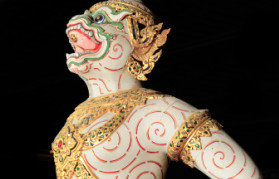A revival of Rodgers and Hammerstein’s The King and I opened recently at the Vivian Beaumont Theater.
Yul Brynner, the great actor who devoted much of his career to The King and I, was known to prepare for each performance by trying to push down the brick wall at the back of the theater.
If you ever saw one of his performances, you may remember his first entrance. He burst into sight in a cloud of energy in silk pantaloons and tight white stockings, came to stop in the middle of the stage with his hands on his hips and his feet apart, and stood with his legs radiating power and purpose.
Yul Brynner was no pushover. He was a physical force on stage. He projected a formidable will, and a fierce confidence. And he had not yet spoken a word.
Ninety percent of emotional communication is nonverbal. Gestures are an unconscious language that we use to express not only our feelings but to generate them as well. By making a gesture, we help produce an internal state.
Amy Cuddy, a faculty member at the Kennedy School of Government at Harvard, has conducted an experiment with her graduate students demonstrating that holding an assertive body posture for as little as 2 minutes increases the amount of testosterone in the body, in men and women.
Few people know that Yul Brynner was exposed to the teachings of Michael Chekhov, one of the greatest Russian actors of the early 20th century, and the nephew of the playwright Anton Chekhov.
Michael Chekhov’s techniques for stimulating inner states were what he called “psycho-physical” in nature, an approach that differed from that of his own teacher, Constantin Stanislavski, the founder of the so-called “Method” school of acting.
If Amy Cuddy and Yul Brynner are right, and I believe they are, then what can we do to increase our executive presence and ignite our speeches and presentations? What can we do to infect our audience with our energy? What can we do to kindle a positive inner state that will be strong enough to move the mountain that stands between the audience and what we need them to do?
The answer is simple: we need to get our act together. Quite literally, we need to integrate, or synthesize our knowledge, our feelings, our purpose, and our imagination, and we need to ensure that our bodies express all that we are, all that we think, feel, want, and imagine.
In essence, the high stakes presenters, the men and women who move mountains, embody the full spectrum of human potential.
